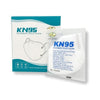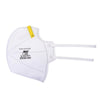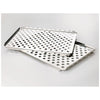- No products in the cart.
Cleanliness in the lab is essential for accurate and reliable results. To ensure that your lab space meets all standards for safety and sterility, you'll need to use certain chemicals that are specifically designed for critical cleaning. This guide will cover the top four chemicals to use when cleaning a lab in order to make sure that your work environment is safe and sanitary.
1. Ethanol or Isopropanol
Ethanol or isopropanol (IPA) is one of the four crucial solutions for keeping your lab space clean. This solution has sanitizing and degreasing capabilities, which makes it ideal for use around sensitive lab materials such as glassware and other delicate instruments. As an added bonus, it also has minimal environmental impact due to its biodegradability.

Working in a laboratory environment requires careful attention to hygiene and sanitation protocols in order to avoid cross-contamination. As such, using the right cleaning products is essential for maintaining a safe and efficient workspace. The two most commonly used chemical solutions for critical lab cleaning are ethanol and isopropanol, both of which have strong disinfecting properties that help reduce the risk of microbial contamination. Ethanol or isopropanol can efficiently sanitize surfaces, remove grease and dirt, and prevent microbial growth. It is important to remember that these chemicals should be handled with care when working in the lab; always follow safety guidelines provided by your institution or local regulatory body when handling hazardous materials.
2. Hydrogen Peroxide
Hydrogen peroxide is another popular disinfectant used in many lab settings. It maintains its active properties for longer periods of time compared to chlorine-based solutions and is ideal for countertops, large surfaces, and equipment that cannot usually be autoclaved. Its ability to kill a wide range of bacteria, spores, and fungi make it an excellent choice for complete sterilization and cleaning around the lab.
3. Hydrochloric Acid
Hydrochloric acid is a chemical agent used for cleaning purpose and sanitation in laboratories. It offers excellent cleaning potential with low risk of damage to the laboratory surfaces and equipment, while providing complete sterilizing benefits. The efficient germicidal properties of this acid make it one of the most important chemicals for critical lab cleaning processes. When combined with other cleansing agents, hydrogen chloride provides an enhanced solution capable of eliminating harmful bacteria, spores, and mold from even difficult-to-reach surfaces.
4. Sodium Hydroxide
Sodium hydroxide (NaOH) is a white crystalline solid that is used in many industries and finds an important place among lab cleaners. Its superior cleaning efficacy, coupled with safety and non-polluting characteristics makes it an ideal chemical for cleaning critical laboratory surfaces. NaOH can be safely used with most metals as well as on electronics, glassware and other fragile laboratory materials without running the risk of damaging the equipment. NaOH is also known to be an effective deodorizer, neutralizing unpleasant odors when added to cleaning solutions.
5. Detergents
Detergents can also be added to sodium hydroxide-based solutions in order to make cleaning much easier. Detergents help lift off stubborn dirt and grease deposits while making sure that no residues remain after the surfaces are cleaned. A variety of detergent solutions are available, ranging from general all-purpose cleaners to more specialized products which contain active ingredients tailored for specific cleaning tasks. While using detergents with NaOH is encouraged, do note that they may require more attention when it comes to rinsing and neutralizing residues in order to prevent any corrosion or residue damages.
Caution when using chemicals for cleaning
It is important to use caution when using chemicals for cleaning and to choose the right cleaning agent for the specific surfaces and materials in your lab. Always follow the manufacturer's instructions and use personal protective equipment when handling chemicals. Some tips to keep in mind include:
- Read the label: Make sure you understand the proper use, storage, and disposal of the chemical.
- Wear protective gear: Use gloves, goggles, and other protective gear as needed to protect yourself from the chemical.
- Use in a well-ventilated area: Many chemicals release fumes that can be harmful to inhale. Open windows or use fans to ensure that the area is well ventilated.
- Keep chemicals out of reach of children and pets: Store chemicals in a secure, out-of-reach location to prevent accidental ingestion or injury.
- Follow the directions: Use the chemical as directed on the label. Do not mix chemicals unless instructed to do so, as this can create hazardous reactions.
Dispose of chemicals properly: Follow the instructions on the label for proper disposal of the chemical and its packaging. Do not pour chemicals down the drain or flush them down the toilet.
Where to Purchase Lab Chemicals
Lab Pro can provide you with all your lab chemical requirements. Various sizes and percentages are available and ready to ship.
About Lab Pro
For over 40 years, Lab Pro Inc. has been committed to delivering the highest quality critical cleaners, hand tools, chemicals, lab equipment, distance learning kits, lab supplies, and cleanroom PPE apparel to medical device companies and laboratories worldwide. To learn more, visit the biggest Lab Supply showroom in California, or contact us online or at 888-452-2776.












































